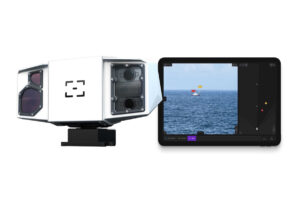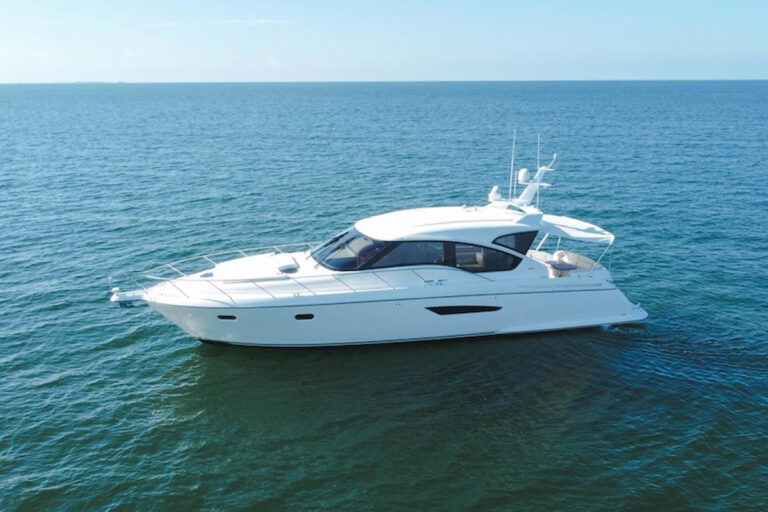
In 2019, I visited KVH’s headquarters in Middletown, Rhode Island, and was amazed by the network operations center. KVH manufactures cellular, Wi-Fi and satellite-communications equipment, and it manages and monitors a proprietary end-to-end network. Standing there, looking at the screens and maps, I could see every KVH-equipped vessel in the world, plus the operational status and performance metrics for each yacht’s KVH antennas.
Now, five years on, KVH is expanding its KVH One Hybrid Network by adding Eutelsat OneWeb’s constellation of low-Earth-orbit satellites, giving yacht owners even more choices for how they want their systems to perform.
Satellite-communications systems have long leveraged geosynchronous (GEO) satellites that orbit around 26,200 miles above equatorial brine. These systems work fine, but they require a significant amount of power to bridge data across all those miles. The commute physically takes time, which is why satcom providers recently have been launching small low-Earth-orbit (LEO) satellites that orbit at elevations of 340 to 745 miles. They reduce power requirements and latency, and provide more satellites so that if a connection is lost, the equipment just finds the next passing LEO.
OneWeb isn’t the only LEO constellation aloft, but it’s the only one, as of this writing, with a hybrid solution involving GEO and LEO satellites. It also employs third-party antennas and guarantees speed, bandwidth and white-glove service.
Eutelsat OneWeb’s journey to low-Earth orbit began in 2012, when the company was formed with the goal of providing fast, low-cost connectivity to otherwise dark areas. In 2016, the London-based company partnered with Airbus to build satellites, and OneWeb’s first tranche of six LEOs attained orbit in February 2019.

The pandemic then stymied the company’s fundraising efforts. It declared bankruptcy in March 2020, but received support from the British government and Indian telecommunications giant Bharti Enterprises. In September 2023, the Paris-based GEO satcom provider Eutelsat merged with OneWeb. Bharti Enterprises, the British government and SoftBank remained significant stakeholders.
Eutelsat OneWeb’s network became operational in 2023, and it has 634 first-generation LEOs in polar orbit. Of these, 588 are active, and the remaining satellites are spares. Each OneWeb LEO operates in one of 12 synchronized orbital planes at an elevation of 745 miles above the equator.
“We’ve got coverage 35 degrees north, including the North and South Americas, and we recently had our coverage launched in Australia,” says Celeste Endrino-Cowley, Eutelsat OneWeb’s director for maritime and energy. “By the end of Q1 2024, we will also have live countries in Asia-Pacific. The remaining regions of the world will also be connected as soon as we complete the rollout of our ground stations and market access.”
Eutelsat OneWeb will offer a range of speeds. The basic option includes downlink and uplink speeds of 20-by-4 megabits per second, while the intermediate option yields speeds of 100-by-20 Mbps. High-end service delivers connectivity of 200-by-40 Mbps. By comparison, KVH’s GEO-based plans have downlink and uplink speeds ranging from 6-by-2 Mbps to 20-by-3 Mbps.
OneWeb also has maximum information rates (read: maximum data throughput) and committed information rates (read: guaranteed speeds). These prevent a tragedy of the data commons if, say, a cruise ship arrives at your anchorage.
As for latency, Endrino-Cowley says that data takes 70 milliseconds to make the one-way commute to or from a OneWeb LEO. By comparison, data typically spends 500 to 700 milliseconds traveling to or from a GEO.
Eutelsat also owns 35 GEOs, which it has integrated with its LEO fleet. Once Eutelsat OneWeb’s ground stations are complete, this integration will mean global, multiorbit, multifrequency coverage, and will allow Eutelsat OneWeb to move data along the most efficient routes. For example, bandwidth-intensive communications can be sent via GEOs, which offer higher throughput levels, while lower-bandwidth communications can travel via LEOs. This setup also opens the door to enabling higher- and lower-speed channels, such as for owners and crew.
Rather than building its own terminals, Eutelsat OneWeb partnered with terminal manufacturers Kymeta and Intellian, which build flat-panel antennas. Eutelsat OneWeb is also looking at antenna solutions through manufacturers that will be able to communicate with both GEO and LEO services. It also partners with companies such as KVH in the United States that resell antennas and airtime, and provide white-glove customer support.
“KVH One is our umbrella name for our multiple-orbit, multiple-channel network,” says Chris Watson, KVH’s vice president of marketing and communications. “The backbone of that has always been our [GEO] network, and then we brought in 5G, and we brought in Wi-Fi, and now we brought in Starlink, and now we’re bringing in OneWeb.”
KVH’s goal, he says, is for different communication channels to create a unified and stress-free user experience. Various costs will be involved. Starlink’s high-performance flat-panel antenna, for instance, fetches roughly half the expected retail price of Intellian’s yet-to-be-released OneWeb-ready flat panel.
“We’re going to be coming to market with OneWeb terminals and airtime pricing that will be competitive in the LEO space,” Watson says. “It’s going to be: What flavor do you like best? The functionality, the capability and the speeds are going to be very comparable.”
Watson also notes that Amazon and Telesat are building LEO networks: “It’s going to become a very robust ecosystem for LEO services in the next couple of years.”
Overall, the future looks bright for low-cost, high-speed LEO communications, especially when each network can serve as a spoke in the greater KVH One communications ecosystem. Based on what I saw during my visit to Rhode Island, KVH’s network can solve connectivity problems before boaters notice them. For yachtsmen seeking smooth data communications, few gloves are whiter than invisible ones.
Have It All
LEO networks are fast, but each has pros and cons. Modest costs mean that yacht owners can spec OneWeb and Starlink panels. For KVH One customers, a network’s bundled Wi-Fi, cellular and GEO-based satcom become a unified option.
Intellian is building OneWeb-ready parabolic antennas. Some of these antennas will be able to communicate with GEO and LEO satellites, while others will require discrete hardware for hybrid-constellation connectivity.









